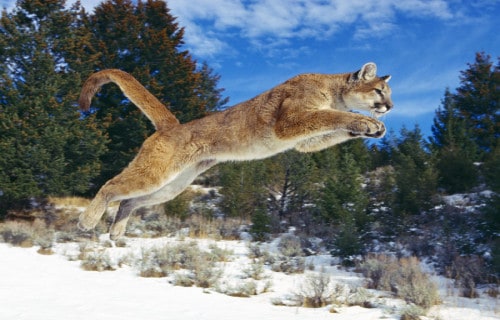
We hope that each of you, our readers, will enjoy and appreciate this article we present about these 5 Wonderful Mammals of Washington. It was certainly our pleasure to gather the information for you. May it provide you with both education and increased awareness.
Certainly, these few species listed herein represent only a portion of the similar species around the globe. It’s our belief, though, that they serve as excellent representations of the members of this Family. Check out some of our other articles for similar marvels.
Moose
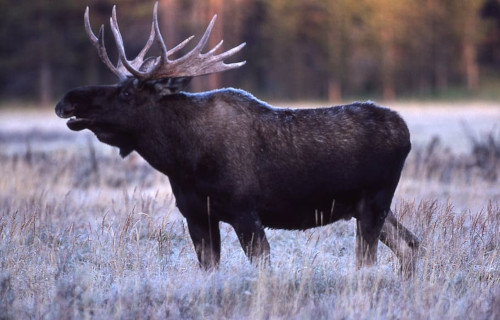
Moose Facts
- Heading up this article about these 5 Wonderful Mammals of Washington comes the magnificent creation of Nature simply named the Moose.
- This massive and magnificent mammal most frequently goes by this simple name within a certain portion of its range. Intriguingly, however, it holds a different common name in another part of its territory. That’s the equally short moniker of Elk.
- Inside of the scientific community, though, the animal is generally better known by its technical title. Thankfully for the layperson, that’s an extremely simple term to pronounce compared to most. That’s because it holds the formal title of Alces alces.
- The remarkable creature received that easy to pronounce name due to the efforts of Carl Linnaeus. The Swedish zoologist accomplished the first official recognition of it as a separate and distinct species. That noteworthy event occurred in 1758.
- Regardless of which of these one chooses to use, it remains an impressive species. It also stands out from it kindred for several reasons. Perhaps most impressively, it’s the largest extant species in the deer family. It’s also the only member of its genus.
- Luckily, the Moose seems to be maintaining a sizeable and comparatively stable population. That pleasant situation further appears to hold true throughout its entire habitat range. The IUCN, therefore, currently lists it as Least Concern on its Red List.
- The majestic animal nevertheless faces the same potential threats to its existence as most species. Most of these stem from the actions of humans. They include such dangers as habitat loss due to human expansion, and climate change, of course.
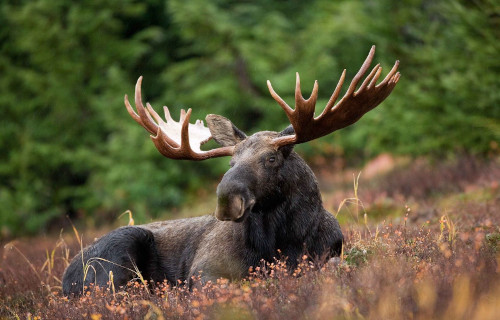
Moose Physical Description
The incredible Moose clearly distinguishes itself from all other known varieties of deer. Obviously, its most attention-grabbing attribute is its sheer size. Yet it certainly holds the appreciation of Nature lovers due to its appearance, as well. Nature truly blessed this marvel.
Though larger than its relatives, it follows a similar pattern regarding its nature. That’s the fact that the animal displays a moderate degree of the physiological characteristic of sexual dimorphism. In its case, this trait manifests itself in not one, but two distinct manners.
In terms of pure size, males of the species attain greater average measurements than do their female counterparts. Males reach a height at the shoulder ranging from roughly 4.5 – 7 ft (1.4 – 2.1 m). These also range in weight from an incredible 838 – 1,543 lb (380 – 700 kg)!
Females, however, reach noticeably smaller dimensions, in both of these categories. These typically have masses ranging from 441 – 1,080 lb (200 – 490 kg). Their overall body height and length also remain accordingly smaller than the males of the remarkable Cervidae.
The nose of both sexes stands out from others of its kind, too. It’s unique among living cervids due to its significantly greater length, relative to body size. The creature also evolved an adaptation allowing it to seal its own nostrils when feeding on aquatic vegetation.
Its the antlers of the Moose that most separate the genders, however. Females lack this feature entirely. Among males, though, these reach impressive dimensions. This varies with age and range, but averages an extraordinary 79 in (2 m) among healthy, mature adults!
- Kingdom: Animalia
- Phylum: Chordata
- Class: Mammalia
- Order: Artiodactyla
- Family: Cervidae
- Genus: Alces
- Species: A. alces
Moose Distribution, Habitat, and Ecology
The extraordinary Moose evolved as native to an extremely wide expanse of the globe. The full extent of that territory surprises many people. That’s because the intriguing mammal developed as endemic to sections of North America, Europe, and a small part of Asia.
In North America, that range covers virtually all of Canada. It also appears in Alaska, and the most northerly portions of the United States. In Europe, though, the animal lives in such countries as Sweden, Norway, and Finland. But in Asia, it’s mainly confined to Russia.
The fascinating creatue evolved very precise preferences for its choice of habitat. As a general principle, individuals avoid regions with little or no snow. Their evolutionary cold-adaptations make this a necessity. They typically try to avoid hotter regions for that reason.
The animal also requires the presence of sufficient vegetation of the appropriate kind. The species most commonly prefers sub-alpine areas where possible, in early winter. During the latter part of that season, however, they move to river valleys with deciduous forests.
The mighty Moose evolved as a browsing herbivore. It feeds opportunistically on an extremely wide variety of flora. This includes such fare as aquatic plants, fruit, and tree shoots. The average adult individual consumes approximately 71 lb (32 kg) of food per day!
The massive mammal understandably has few natural predators, due to its great size. Only siberian tigers hunt mature individuals solo. Packs of wolves sometimes will as a group, though. In certain parts of its range, black bears and cougars sometimes prey on the calves.
Hoary Marmot
Hoary Marmot Facts
- Next up in this compilation of 5 Wonderful Mammals of Washington comes the intriguing rodent best known as the Hoary Marmot.
- The most notable thing about the remarkable work of evolution might surprise many of you. That’s because this animal actually represents a variety of ground squirrel. This incredible creature further ranks as the largest in its range, surprising one again.
- This amazing mammal additionally remains a surprisingly intelligent creature. This statement remains evidenced by its demonstrated patterns of behavior. That’s due to the fact that while the colony feeds, a few individuals watch for predators.
- As, a result of this behavioral pattern, if a threat appears, the ever vigilant sentry quickly emits a high-pitched warning cry. Due to the nature of this outcry, in some parts of its range the Hoary Marmot has been given the name of whistle pig.
- Quite thankfully, its numbers appear to be both sufficient and stable, at least for the moment. For this reason, the IUCN currently ranks the beautiful creature as Least Concern. That could potentially change, however, due to the actions of man.
- Sadly, numerous factors related to human civilization now threaten the species. Habitat loss certainly ranks as one of these, of course, due to human expansion. Its greatest threat, however, must be considered to be the ongoing effects of climate change.
Hoary Marmot Physical Description
Quite amazingly, that the impressive Hoary Marmot represents a large type of ground squirrel determines much. It has a bulky build, with a broad head, and also short, but powerful limbs. It also, however, displays a marked degree of sexual dimorphism.
In its specific case, though, this manifests itself in the fact that the males grow much larger than females. That applies to both it and its subspecies. Mature males average a body length of 22 in (55.9 cm). These same individuals also have a tail of about 9.8 in (25 cm).
The females, meanwhile, only average roughly 17.3 in (43.9 cm) in body length. These further possess a tail of 6.7 in (17 cm). The same females also tend to be somewhat less stocky in build. Weights for both genders vary significantly, depending on the season.
The term hoary remains a reference to the fur on the upper back and shoulders of the fabulous Hoary Marmot. That’s because this part of its fur displays a silvery-gray color. This remains in stark contrast to the tan or reddish-brown color the rest of the body shows.
- Kingdom: Animalia
- Phylum: Chordata
- Class: Mammalia
- Order: Rodentia
- Family: Sciuridae
- Genus: Marmota
- Species: M. caligata
Hoary Marmot Distribution, Habitat, and Ecology
Perhaps most notably, the fabulous Hoary Marmot only inhabits a comparatively limited portion of northwest North America. This region includes parts of Idaho, Washington, and Alaska, in the United States, and also British Columbia in Canada.
Even more precisely, the intrepid rodent also displays highly specific preferences regarding its choice of habitats. These primarily consist of mountainous alpine ecosystems. It also thrives best at altitudes ranging from sea level up to as much as 8,200 ft (2,500 m).
Within that range, however, individuals frequently live in either areas of grasslands and sedge, or rocky regions. It also inhabits several small islands near Alaska, however. There, the animal tends to live near the shoreline, having proven itself to be adaptable.
The Hoary Marmot further appears to be entirely herbivorous in terms of its dietary nature. Although exact diets vary, this fascinating large rodent mainly consumes grasses, sedge, leaves, and flowers. It also evolved as diurnal in nature, like many mammals.
Remarkably, the animal additionally has a highly prolonged hibernation period. In point of fact, it commonly spends 7-8 months of the year in this state. This period it spends in large, deep burrows, commonly shared by a colony of as many as 36 individuals.
Cougar

Cougar Facts
- Appearing in the third position in this gathering of 5 Wonderful Mammals of Washington, the amazing Cougar does not do so due to any lack of impressiveness.
- This relatively short term serves as but one of the common names assigned to this magnificent wild feline. It other common names include the mountain lion, puma, painter, panther, and catamount. The variety of names occur due to its wide range.
- Scientists, meanwhile, know the stunning feline by the term Puma concolor. Regardless of the name one uses for it, the animal remains one of the most recognizable of the smaller wild felines. It’s also the most widespread of any in its Hemisphere.
- The renowned Swedish zoologist, Carl Linnaeus, holds the credit for the first acknowledged scientific recognition and naming of the species. This achievement he accomplished in 1771. The name he chose, however, later changed several times.
- This breathtaking feline obviously evolved as a slender and agile member of the cat family. It also holds a unique distinction. That’s because, though not technically one of the so-called big cats, it’s the fourth largest of all known wild felines.
- Even though its population doesn’t compare to past numbers, this appears stable throughout its range. The IUCN, therefore, currently lists it as Least Concern. It does face several threats, including the ever-increasing danger posed by climate change.
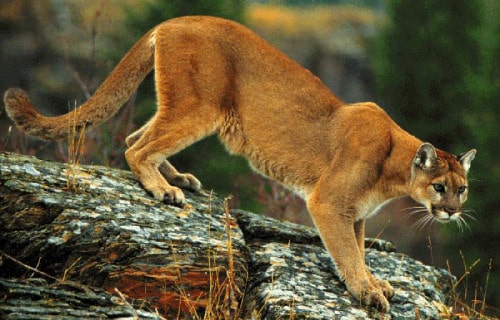
Cougar Physical Description
Unlike some species, the breathtaking Cougar actually impresses us with its size, in addition to other factors. The animal also, however, displays the physiological characteristic of sexual dimorphism. In this, in fact, it mirrors virtually all know types of feline, wild and domestic.
In its specific case, though, this trait manifests in terms of size, with males of the species attaining slightly greater lengths and weights. Mature adults of both genders, however, vary greatly in height, averaging between 24 -35 in (60 – 90 cm) tall at the shoulders.
In terms of length, meanwhile, is where the size differences appear the most obvious. The males of this feline attain an average nose-to-tail length equaling roughly 7.9 ft (2.4 m). Females, however, generally reach an overall length of about 6.7 ft (2.05 m).
It bears pointing out, though, that of this total measurement, the tail itself comprises 25 – 37 in (63 – 95 cm) of this. The males, meanwhile, typically reach a weight of between 115 – 220 lb (53 – 100 kg). Females, on the other hand, average 64 – 141 lb (29 – 64 kg).
The Cougar also boasts other impressive statistics. Its rounded head displays erect ears. The feline has a jaw and forequarters powerful enough to grasp large prey. It also has five retractable claws on the forepaws, and proportionately the largest hindlegs in the cat family.
- Kingdom: Animalia
- Phylum: Chordata
- Class: Mammalia
- Order: Carnivora
- Family: Felidae
- Genus: Puma
- Species: P. concolor
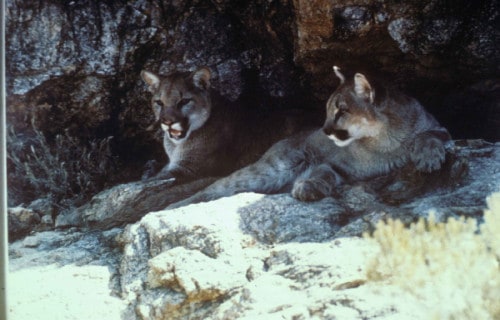
Cougar Distribution, Habitat, and Ecology
Pleasantly surprisingly, the gorgeous Cougar inhabits a comparatively large section of the globe. More precisely, it appears in a range that extends from parts of Canada to the Andes in South America. Its greatest concentration, however, is concentrated in North America.
Aiding in its continued existence as a species is the fact that it evolved as a highly adaptable creature. This flexibility allows it to inhabit a wide variety of habitat types within its native range. Most notably, though, these include forests, lowlands, mountains, and arid climates.
Its incredible physique allows the impressive feline some of the greatest leaping and short-sprint ability of any animal. Individuals have the ability to jump as high as 18 ft (5.5 m) in one bound. These also evolved the capacity to leap as far as 40-45 ft (12-14 m) horizontally.
But Nature did not stop there. This animal also boasts some extremely impressive speeds. The top running velocity of the animal also ranges between 40-50 mph (64-80 kph). They remain, however, best capable of short, powerful sprints as opposed to long chases.
The remarkable Cougar also feeds entirely as a carnivore. As a supremely successful generalist predator, the mammal further feeds opportunistically. Specimens therefore eat any animal they can catch, from insects to large ungulates in excess of 1,100 lbs (500 kg).
Investigations in Yellowstone National Park showed that elk, followed by mule deer, were the animal’s primary targets. The mammal further evolved as adept at climbing, allowing it to evade canine competitors. Although not strongly associated with water, it does swim.
Gray Fox
Gray Fox Facts
- Our next choice for inclusion in this compendium of these 5 Wonderful Mammals of Washington is the only canine on the list, the amazing Gray Fox.
- This somewhat diminutive but still fascinating creation of Nature most frequently goes by the partially descriptive common name used here. It also has several other alternates, though, These include the maned fox, tree fox, and common gray fox.
- Its formal name, however, is significantly harder to pronounce, perhaps even for experienced professionals. That’s because the official term applied to this marvelous mammal in the halls of science is the tongue-twisting term Urocyon cinereoargenteus.
- The visually distinctive species further received this appellation due to the work of the respected German naturalist, Johann Christian Daniel Schreber. He accomplished the first official recognition of the animal as a separate and distinct species, in 1775.
- Intriguingly, from a scientific standpoint, the creature represents one of only two members of its genus, Urocyon. Both it and the other member genetically represent the closest known surving species, out of all known canids, to a common ancestor.
- For the moment, the Gray Fox appears to be maintaining a population base that’s both stable and sufficient. The IUCN, therefore, currently lists it as Least Concern on its Red List. That holds true despite a reduced population in certain portions of its range.
- This marvel of Nature nevertheless faces some potential threats to its continued existence. Habitat loss, largely due to human encroachment naturally presents a problem. The greatest threat it faces, though, likely consists of ongoing climate change.
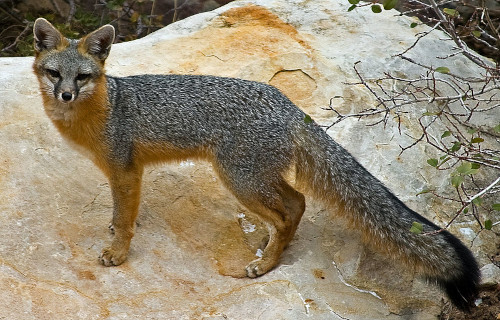
Gray Fox Physical Description
The magnificent animal most frequently known as the Gray Fox manages to pack all this awesomeness into a relatively small body. This merely serves to prove the point that physical size remains wholly irrelevant when considering the impressiveness of a species.
Unlike many of its relatives, however, this creature displays little noticeable degree of the physiological characteristic of sexual dimorphism. This fact further applies to both physical size, and color patterns. The precise reason for this, though, remains unknown.
Due to this, distinguishing the separate genders from a safe distance can be difficult, even for trained observors. The average adult, though, reaches a body length of between 19.1 – 26.9 in (48.5 – 78.2 cm). The long tail, though, adds an extra 10.8 – 17.4 in (27.5 – 44.3 cm).
The weight of individual specimens, however, tends to vary significantly. This often ranges from as little as 7.9 lb (3.6 kg), to as much as 15.4 lb (7 kg). Exceptional specimens do occur on occasion, though, These sometimes reach a weight of up to 20 lb (9.1 kg)!
The color pattern of the Gray Wolf presents a striking image to the viewer, as well. The upper parts typically present a grizzled pattern, with a black stripe extending to the end of the tail. It also manifests an off-white on the throat, chest, belly, hind legs, and ears.
- Kingdom: Animalia
- Phylum: Chordata
- Class: Mammalia
- Order: Carnivora
- Family: Canidae
- Genus: Urocyon
- Species: U. cinereoargenteus
Gray Fox Distribution, Habitat, and Ecology
Fortunately for the Gray Fox, as well as those of us who appreciate Nature, the canid evolved as native to a relatively large swathe of the globe. In fact, it’s actually the only known wild canid with a natural range that includes both North America and South America.
More precisely, however, the wild canine natively inhabits a range that extends as far north as the southern portions of the country of Canada. From there, that range extends through most of the United States, excluding the northwestern mountains of that country.
From there, its territory extends throughout Central America, and into the extreme northern portions of Venezuela and Colombia. In all portions of that range, though, it displays a decided preference for certain specific types of habitat in which to make its home.
The fascinating animal also displays a strong preference for regions consisting of wooded, rocky, bushy regions. In some small regions, it further manifests a strong fondness for regions of rocky bluffs possessing a dense covering of brush for its habitat.
Like most of its relatives, the Gray Fox evolved as a primarily nocturnal animal. It typically spends most of its days concealed in either burrows, hollow trees, or stumps. It’s also omnivorous, feeding on small prey, insects, and certain local plants, especially fruit.
In one manner, however, this extraordinary animal remains completely unique. That’s due to the incredible fact that it’s the only known canid to routinely climb trees! There, it often make sits home as high as 30 ft (9.1 m) up in the branches, and climbs like a cat.
Striped Skunk
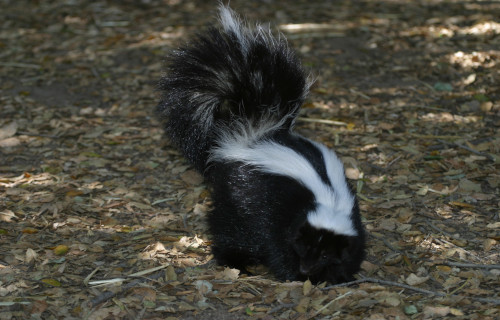
Striped Skunk Facts
- Completing this article about these 5 Wonderful Mammals of Washington we give you the misunderstood beauty named the Striped Skunk.
- This beautiful small mammal with the unfortunate reputation most frequently goes by the common name due to its appearance. It does have a few other general monikers, though. Those include common skunk, northern skunk, and prairie polecat.
- Within the scientific community, however, it’s typically referred to by its technical title. That, thankfully is a relatively simple name for the layperson to pronounce. That’s true since the animal bears the official moniker of the Mephitis mephitis.
- The creature received that distinctive formal title due to the efforts of the German naturalist, Johann Christian Daniel von Schreber. He accomplished the first acknowledgement of it as a separate and distinct species. That occured in 1776.
- Regardless of which appellation one uses, it remains one of the most easily recognizable animals in its native range. It’s even become immersed in the local culture, appearing as a character in various cartoons. A total of 13 subspecies also exist.
- Fortunately, the remarkable Striped Skunk seems to be maintaining a sizeable and stable population base. That pleasant trend further appears to hold true throughout the entirety of its habitat zone. The IUCN, therefore, now lists it as Least Concern.
- The intriguing creature nevertheless faces some very real potential threats to its continued existence as a species. In this, it’s in the same situation as most species. It’s endangered by the dual perils posed by habitat loss and ongoing climate change.
Striped Skunk Physical Description
The remarkable Striped Skunk presents the viewer with a captivating appearance. It fully deserves appreciation for the beauty Nature gifted it with. It’s not an overly large animal, in terms of pure physical size. Nature, however, blessed it with other attributes.
Like many fauna, the mammal presents a certain degree of the physiological characteristic of sexual dimorphism. In its specific case, this trait manifests itself in terms of sheer physical measurements. Due to that tendency, males attain a larger size than females.
That difference remains minor, though. As a general principle, the males grow to about 10% larger than their female counterparts. This includes both weight and length of body. Exceptional individuals do naturally occur, however, completely regardless of their gender.
Overall, individuals attain an average head-to-tail length equaling between 20.5 – 30.3 in (52 – 77 cm). Body mass also varies accordingly. Specimens therefore typically display weights ranging from 4 – 9.9 lb (1.8 – 4.5 kg). Some do reach as much as 12 lb (5.5 kg), though.
The body of the Striped Skunk is perhaps best described as stout. It’s limbs develop as relatively short, while it has a small, conical head. The thickly-furred tail usually accounts for about half the overall length. The front feet have long claws, but the rear one’s are shorter.
Yet its the color pattern of the animal that catches the eye first. The precise nature of this varies widely between individuals, but a basic pattern remains. That generally consists of a deep black background, with the well-known white stripe extending from nose to tail tip.
- Kingdom: Animalia
- Phylum: Chordata
- Class: Mammalia
- Order: Carnivora
- Family: Mephitidae
- Genus: Mephitis
- Species: M. mephitis
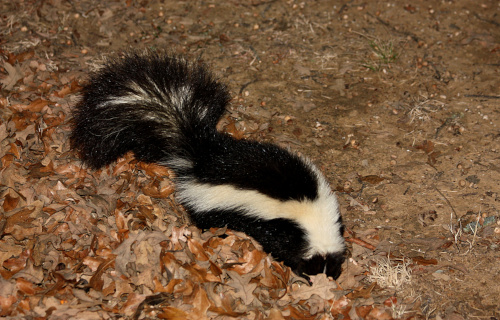
Striped Skunk Distribution, Habitat, and Ecology
The beautiful Striped Skunk evolved as endemic to a comparatively wide expanse of the world. That precise region of the globe doesn’t surprise many people, however. That’s because it developed as endemic to much of what’s now known as North America.
The majority of its natural zone of habitation includes the entirety of the continental United States. To the north, though, it appears in the approximate southern half of the country of Canada. Southerly, the oft-maligned animal lives in a small part of northern Mexico.
Nature blessed this natural marvel with an impressive adaptability in terms of its habitat choices. Due to that flexibility, it appears in a wide range of ecosystems. These include such diverse regions as rocky outcrops, wooded ravines, and moderately brushy corners.
It does, however, show a moderate preference for areas of mixed woodlands. Its adaptability never ceases to amaze, though. As a result of human presence, in some regions, such as the state of Illinois, a few populations actually prefer cultivated areas to uncultivated.
It’s the defensive tactics of the Striped Skunk that gathers the most attention. Two glands near the base of the tail produce an extraordinarily odorous liquid. The animal can spray this at will for a respectable distance. Due to the strength of this, it has few predators.
It’s mainly carnivorous in terms of diet. The animal mostly feeds on insects, such as grasshoppers, crickets, beetles, and caterpillars. Yet, it sometimes eats eggs, voles, mice, as well as fish and small reptiles. Various fruit, such as berries, also form an occasional treat.

5 Wonderful Mammals of Washington
We hope that each of you enjoyed reading, and hopefully learning from, this article we’ve written about these 5 Wonderful Mammals of Washington. It’s also our hope that doing so has left you with either a new or renewed appreciation for such wonders of Nature.
Unfortunately, however, many of their kindred around the world now find themselves facing strong threats to their continued existence as a species. Many of those dangers, in fact, stem from the actions of mankind. We must do all we can to protect and preserve them all.
Check out our other articles on 7 Magical North American Moths, Spectacular Dolphins Throughout Our World, 10 Dazzling Denizens of the Depths, The Mighty Tornado
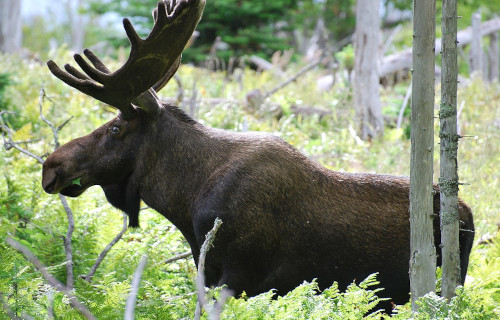
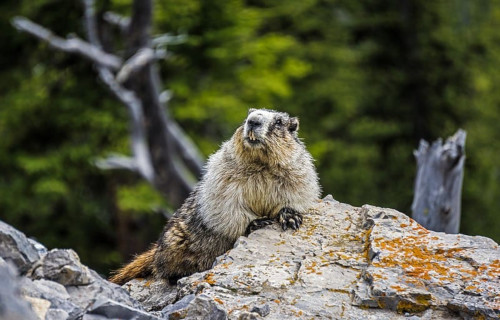
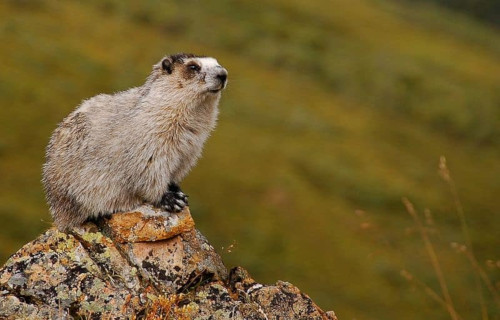
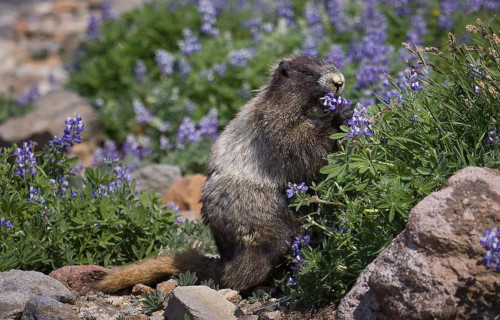
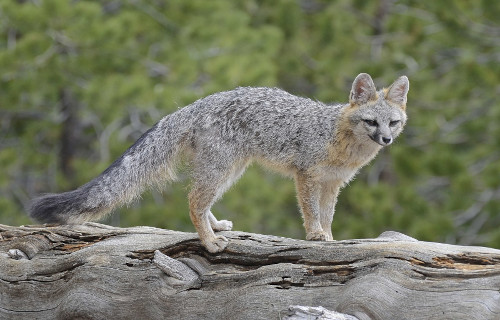
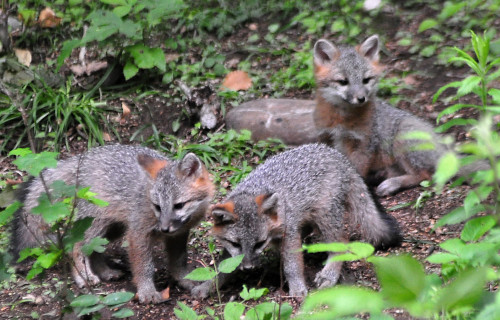
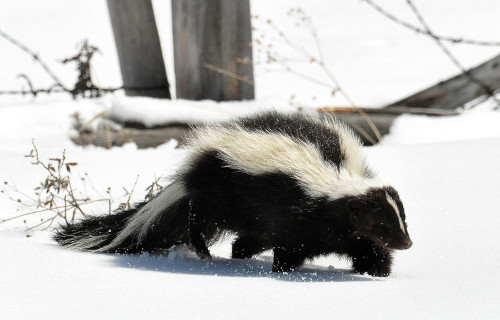









Leave a Reply